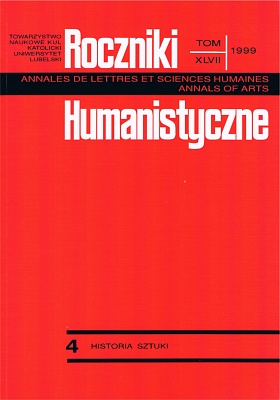Henryk Musiałowicz's Way to Black and White
Abstract
Henryk Musiałowicz is one of the lesser known Polish artists, and yet honoured with numerous awards and exhibitions. Most of them were organized abroad. He is an interested example of a versatile artist, conversant with many plastic techniques, and standing at the gate of artistic career. Giving up his previous experience, he managed to start his artistic quest anew, with the help of the simplest plastic means. He gave up colour, a mimetic form of painting kindred to colourists, on behalf of works painted with the drawing-pen and Indian ink. Making this decision in 1956, he gave up the post he held at the Union of Polish Artists and withdrew from the then artistic milieu. He consciously decided to be an outsider; he made efforts to paint outside the transitory modes and tendencies in art.
He belongs to that generation of artists who made their debut right after the Second World War. At the moment of his debut, he was already a mature artist with a quite clear individuality, a painter who apart from painting pursued also other disciplines of art (glass-painting, decorative painting and artistic craftsmanship). Similarly as in the case of other artists of his generation, the war has left its stamp on his painting.
The artist was born on 5th January 1914 in Gniezno. He graduated from the State School of Decorative Arts and Artistic Craftsmanship. In 1937 he studied in Warsaw Academy of Fine Arts in the workshop of professor of Leonard Pękalski, obtaining his diploma after the war in 1948. During the war, together with his friends, he started almost clandestine encounters with professors. Many of his friends belonged later to the group “Warszawa”, with which the artist was connected until 1949. He was highly valued by Jan Cybis and remained under the formal influence of colourists (he differed from them, above all, with his more emotional approach to colour, gloomier and less effective palette) he decided to give up colour.
In 1956 Musiałowicz managed for the first time to leave Poland on a trip organized on behalf of the ZPAP to the Netherlands. A year later he left it for a second time and stayed two months in Paris, having been granted a scholarship.
In Amsterdam he visited the exhibitions of van Gogh and Picasso, and in Hague those of Rembrandt and Vermeer. Communing with the later portraits by Rembrandt, the expressive painting of van Gogh, he came to a conclusion that giving up the literal recreation of nature, the aesthetic effects, and seeking one's own language and form is that which is essential in art. He was greatly impressed by the drawings accompanying Picasso's Guernica, being sketches to that painting. He was struck by its power of synthesis, expression and their almost abstract sign. In Paris he was equally interested in the Louvre and the Museum of the History of Man. In the relics of archaic and ancient arts, in the artifacts of medieval, modern and contemporary art he sought what was common, what decided about that which made them one art. He was extremely delighted with the legacy of artistic and cultural Europe, with the masterpieces he found, for he was a sensitive observer and had a contact − as wide as never before − with the art of many cultures and epochs. The reflections he cherished after that encounter became for Musiałowicz a stimulus to search more meaningful forms, more archetypical in their expression.
After his return from the Netherlands the theme of his first black and white drawings were the Landscapes from Mielnik and women's heads, composing the cycle called simply Heads.
The motif of women's heads has become an occasion to refer to Rembrandt's portraits. Anonymous faces most often constructed by means of the basic means: stroke of lips, strokes of eyebrows and nose, dots of eyes, oval of the head, outlines of the arms and a simple headgear, vibrating and interpenetrating spots of Indian ink of various values of grey and black. The best known cycles, however, of his works from that period are the fantastic Sea Bottoms, Animalistic Landscapes (series of paintings inspired by nature), the Ruins of Warsaw and the War against Man (the cycles resulting from his war experiences) and the best known Portraits from the Imagination (works in which one finds a characteristic motif of that artist, i.e. an outline of human bust, present in the majority of his paintings until the 1990s).
One of the most important collective exhibitions, in which Musiałowicz took part, was the exhibition entitled “Le visage de l'homme dans l'art contemporain” in Geneva in 1967. At that exhibition we could find his paintings, aside to such artist as Francis Bacon, Giorgio de Chirico, Salvadore Dali, Jean Dubuffet, David Hockney, Fernand Léger, Pablo Picasso, Andy Warhol and Wols. It was also one of the last exhibitions at which the artist presented the majority of his black and white paintings.
Colour, treated only in a symbolical manner, appeared again in Musiałowicz's painting as late as 1964 − in the cycle of the Portraits of the Imagination.
Copyright (c) 1999 Roczniki Humanistyczne

This work is licensed under a Creative Commons Attribution-NonCommercial-NoDerivatives 4.0 International License.





